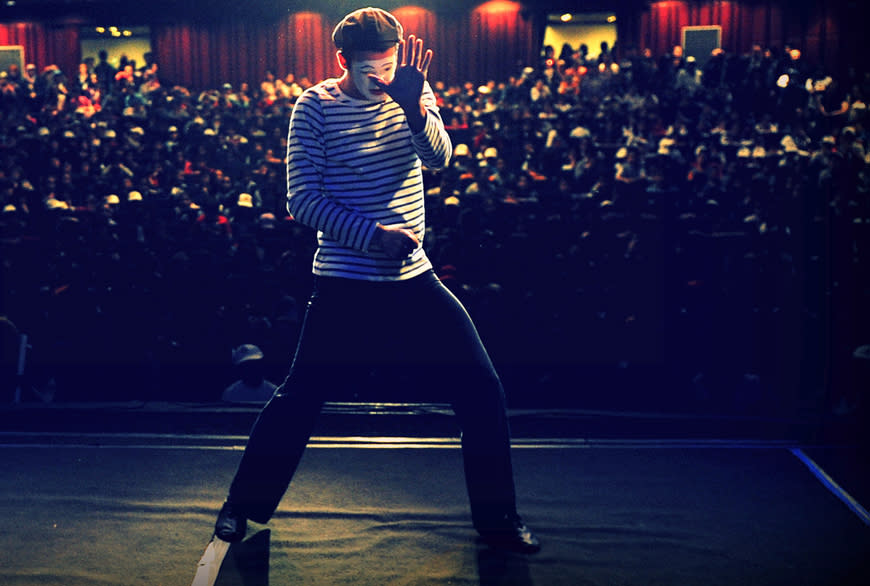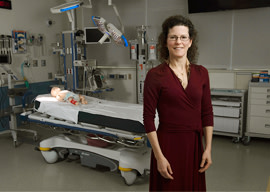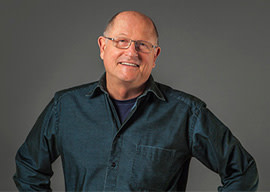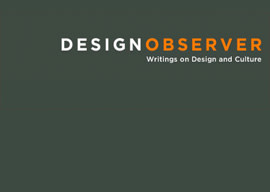
You walk into the restaurant, but this is no ordinary eatery. In fact, the whole joint is made out of... white foam core. The restaurant workers are, however, real. You’re greeted by a welcoming face and a smiling introduction. “What brings you in today?” asks the host. You consult a digital menu kiosk, click on a few buttons that reflect your personal preferences, and hand over a paper credit card (why not! It’s a foam core restaurant!). The cashier passes you a tray. You see real food and hear the sizzling sounds of gastronomy and some lively, lousy techno music. The chef at the end of the counter packs your food and sends you on your way. You head to a table and are about to tuck into your meal—and all of a sudden, an interviewer stops you cold. You hand over the tray and answer a few questions about your experience.
What in the name of Bobby Flay is going on?
Theatrical prototyping helps us understand how the various elements of an experience come together and resonate—or don’t—with potential guests, clients, and designers.
Remember playing “pretend” as a kid, in a plastic miniature kitchen with plastic spatulas, pans, an oven, and sink? At EPAM Continuum, we call the professional version of this theatrical prototyping, and it’s how we design experiences. Theatrical prototyping helps us understand how the various elements of an experience come together and resonate—or don’t—with potential guests, clients, and the designers themselves. Walking through an experience, in a one-to-one white foam core mock-up, before constructing a real building (or restaurant) provides a deep understanding of how successful a service design concept might be before going to market.
Renderings, small scale models, and small façade mockups show what a future physical space would look like, but they will never embody the human interactions that bring an experience together in a cohesive way. Companies often rush to build without knowing if an experience works both functionally and emotionally. Theatrical prototyping helps them step into the role of users and employees, bringing the spatial experience to life so that they can understand its value. Before jumping into theatrical prototyping, it is important to approach this type of work with a solid understanding of the objectives, the learning goals, the right customers to test with, and success criteria.
There are three key elements to creating to theatrical prototyping: the script, the stage and props, and the special effects.
The Script
We base our scripts on real customer experience scenarios. They represent how we imagine both employees and customers might feel during each customer touchpoint. The dramatization helps instruct employees on the proper way to interact with customers. The right approach can include tone of voice, rhetoric, and gestures. And while we write scenarios based on our research in the field, in the theatrics of prototyping, we sometimes throw in unexpected customer reactions to show how quickly service design can go “off book.”
For example, consider this script:
INT. RESTAURANT—DAY
CUSTOMER walks into the restaurant and tentatively looks around. She is met by the enthusiastic EMPLOYEE.
EMPLOYEE
Welcome! Have you been here before?
CUSTOMER
Nope.
EMPLOYEE
Well then, double welcome. Can I take your order?
CUSTOMER
I’d like Combo A, but could I get an extra side?
EMPLOYEE
Sure thing! That would be an extra $1. Is that okay with you?
CUSTOMER
Of course.
CUSTOMER hands over a paper credit card. EMPLOYEE smiles and runs it through a "payment reader” (really a white foam core sandwich).
The stage pieces together all of the different elements—visual, aural, tactile—that make a scene real.
In this scenario, the EMPLOYEE did not anticipate the question about getting an extra side. The introduction of a surprise into the script helps our clients comprehend the unexpected minor customer reactions that sometimes take place during service. This contributes to building a robust service experience model, one that gives employees clarity on how to react during an uncertain moment.
We find it useful to play out scenarios in which the interaction doesn’t go smoothly, so that we can coach employees in service recoveries.
The Stage and Props
Just like watching a Broadway show or playing “pretend” in a tiny plastic kitchen, the stage provides the context in which an experience takes place. It creates the space for a narrative to unfold and actors to act. It pieces together all of the different elements—visual, aural, tactile—that make a scene real.
In the case of experience design, many ideas are manifested beyond just the interactions between customers and employees. They exist as props that could be tangible objects, space layouts, or digital interactions. Rewinding back to our foam core restaurant: the chairs, the menus, the iPad screens, the utensils, the uniforms, and the wayfinding work together to put customers and clients into the right mindset—which gives us valuable feedback to evaluate our design properly.
A stage and/or props can be set in a warehouse or in a live environment for valuable real-time feedback and evaluation. For example, for a project with Holiday Inn, we built an entire lobby to help us understand what that experience might feel like to guests before remodeling and building several hotels across the country. We needed the stage to give our guests scale and set their behavior/expectations. And in our digital wayfinding project for Southwest Airlines, we built kiosks and stations with screens encased with white foam core in the Dallas Love Airport that real customers would interact with to find their gates.
Theatrical prototyping helps us test new concepts at a low fidelity.
The Special Effects
Special effects are the sprinkles on top. Lighting, music, and sounds heighten the senses and can also affect the overall mood/tone of the experience. Back in our white foam core restaurant, the sound of a crackling grill or a whirring blender enhances the believability of the service drama. Even ambient restaurant noise sets the stage to help everyone imagine the experience.
Hungry for More?
Ultimately, you'll find, the effects of theatrical prototyping are quite special. First, theatrical prototyping helps us test new concepts at a low fidelity, informing clients about how these ideas will perform in front of potential customers. Second, it can help clients understand what makes a concept come together from so many different elements to build a differentiated and valuable experience.
You’ve just read this article. Maybe you’re feeling a little peckish. Maybe you want to know more about theatrical prototyping. Maybe you’re thinking about those theatre tickets you’ve been meaning to buy or reconsidering the value of your kids playing “pretend.” In any case, watch out: You might soon be prototyping some tasty new ideas....
Photo by Fatih Kılıç on Unsplash




